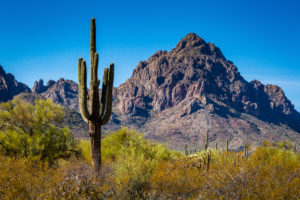
Click for more images of Saguaro cacti.
Along the mountain ridges,
Across the desert floor;
Arms like verdant armor,
Stalwarts guard our door.
Shading for the lizard,
Haven for the wren,
Source of inspiration,
For past and present men.
—Earl Bloss, “Saguaros,”
Arizona Highways, 3/73
Our arrival to the Sonoran desert was announced by the appearance of the majestic Saguaro cactus and, disappointingly, the ubiquitous flag-like plastic bags attached to their spines. Entering Saguaro National Park, the plastic generally disappeared as we enjoyed the final mile or so along Picture Rocks Road to Phil’s tidy home and botanical gem bordering the west side of the park.
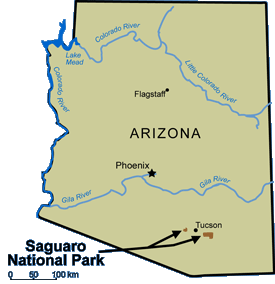 The Saguaro is by far the prominent feature of Phil’s expanded neighborhood and they only grow in areas featuring optimal elevation and sunlight. This cactus requires summer rains for its seeds to germinate and doesn’t deal well with frost. For that reason, in the northern end of its range, Saguaros tend to grow on south-facing slopes where morning sunlight raises the temperature above freezing. In hotter regions, it thrives in flatter areas of hot, granitic soil. The Sonoran desert is perfectly suited for these monoliths and they thrive in and around Tucson, especially in the western section. We did see sporadic forests of Saguaro while driving up Interstate-10 to Phoenix and, later, to Prescott. Each occurrence conformed to an increase in elevation and adequate solar access.
The Saguaro is by far the prominent feature of Phil’s expanded neighborhood and they only grow in areas featuring optimal elevation and sunlight. This cactus requires summer rains for its seeds to germinate and doesn’t deal well with frost. For that reason, in the northern end of its range, Saguaros tend to grow on south-facing slopes where morning sunlight raises the temperature above freezing. In hotter regions, it thrives in flatter areas of hot, granitic soil. The Sonoran desert is perfectly suited for these monoliths and they thrive in and around Tucson, especially in the western section. We did see sporadic forests of Saguaro while driving up Interstate-10 to Phoenix and, later, to Prescott. Each occurrence conformed to an increase in elevation and adequate solar access.
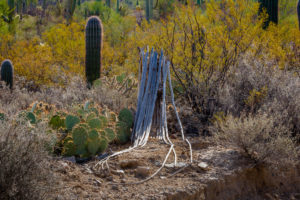
a fully grown one can weigh 6,000 pounds.
When hiking through the desert with Phil, we were surrounded by Saguaros in varied stages of growth. Germination requires protection by a nurse plant—often a Palo Verde tree—that protects it from the severity of the desert. It’s only when a Saguaro is around 50 years old that it begins to branch, often at the same point above the ground. It will later develop additional branches further up the main trunk. Covering the woody skeleton is an accordion-like surface, the pleated skin fluctuating as it absorbs water from the parched soil.
Several different kinds of birds create nest holes in saguaro cactus. The Gila woodpecker creates small holes at midlevel on the cactus where the ribs are far apart and feeds on larvae under the spiny cactus skin. The larger gilded flicker drills larger holes higher up where ribs are close together and is able to do so because its beak is strong enough to break through the wooden ribs. After nesting, these holes are sometimes claimed in late winter or early spring by Ferruginous Pygmy-owls, who begin their nesting in abandoned cavities of trees or cacti like the saguaro and organ pipe (we habitually trained our binoculars on these temporary quarters without any sightings).
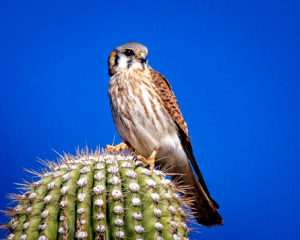
Click for more wildlife images.
Millions of living Saguaros thrive in Saguaro National Park, and hiking along the trails is entertaining not only for the often comical display of branches and trunks but also for a myriad of birds that use the Saguaro as lookouts. On this trip we saw Red-tailed hawks, Gila Woodpeckers, a Gilded Flicker, Eurasian Collared Doves, Mourning Doves and a pair of Kestrels using the stately Saguaro for a respite and/or for a hunting platform.
After a couple days with Phil, we headed down to Green Valley for an always pleasant visit with Susan & John that served as the hub for day trips to Madera Canyon, the Ruby Road loop from Arivaca to Rio Rico (the final several miles through gorgeous canyons and buttes), and several visits to Tubac eateries. Driving the loop counter-clockwise from Rio Rico to, perhaps, Sycamore Canyon, is a shorter option comprising birding the canyons and returning to I-19 in the afternoon with the setting sun at your back. We then drove an hour to Benson to connect with long-time pals Mel and Al before heading back up Phoenix to drop off the the rental. The final 4 days of this whirlwind winter break was spent in Prescott for a short visit with Sumiko, Dave, and fellow-collecting enthusiast, Yunko. Julie & Rick stopped by for a Canadian Academy reunion highlighted by Skipper Dave’s multi-media presentation of our upcoming week-long cruise in Canada’s Desolation Straits.
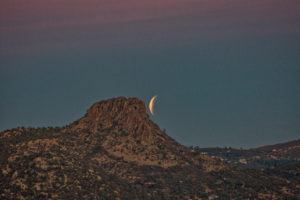
On the morning of our departure, a lunar trifecta occurred consisting of a “Blue Moon” (the second full moon in a month), a “Super Moon” (its physical presence closer to the earth making the moon appear larger) and, as if to up-stage the other two, there was a total eclipse of that super blue blood moon right before sunrise (the “blood” is attributed to a reddish hue the moon takes on just before and after total eclipse). And we thought the wildlife was extraordinary!
Birds identified during this leg of the journey:
Acorn Woodpecker, American Kestrel (Female), Anna’s Hummingbird, Arizona Woodpecker, Bald Eagle (juvenile), Bewick’s Wren, Black Phoebe, Black Vulture, Black-tailed Gnatcatcher, Black-Throated Sparrow, Blue-Gray Gnatcatcher, Bridled Titmouse, Bushtit, Cactus Wren, California Towhee, Canyon Towhee, Chipping Sparrow, Cooper’s Hawk, Costa’s Hummingbird, Coyote, Curve-Billed Thrasher, Dark-Eyed Junco (Arizona), English Sparrow, Eurasian Collared Dove, European Starling, Gamble Quail, Gila Woodpecker, Gilded Flicker, Gray Flycatcher, Greater Roadrunner, Hammond’s Flycatcher, Hepatic Tanager, Hermit Thrush, House Finch (Female), House Finch (male), House Sparrow, Hutton’s Vireo, Juniper Titmouse, Ladder-Backed Woodpecker (Female), Lark Sparrow, Lincoln’s Sparrow, Magnificent Hummingbird, Mexican Jay, Mockingbird, Mourning Dove, Northern Cardinal, Painted Redstart, Phainopepla (male), Phainopepla (female), Pine Siskin, Pyrrhuloxia, Red-Breasted Nuthatch, Red-naped Sapsucker, Ruby Road Loop, Ruby-Crowned Kinglet, Rufous-Winged Sparrow, Say’s Phoebe, Verdin, Vermillion Flycatcher, Western Bluebird (Female), Western Bluebird (Male), Western Meadowlark, White-Breasted Nuthatch, White-Crowned Sparrow, White-Throated Sparrow, Wild Turkey, Yellow-Eyed Junco, Yellow-Rumped Warbler,
